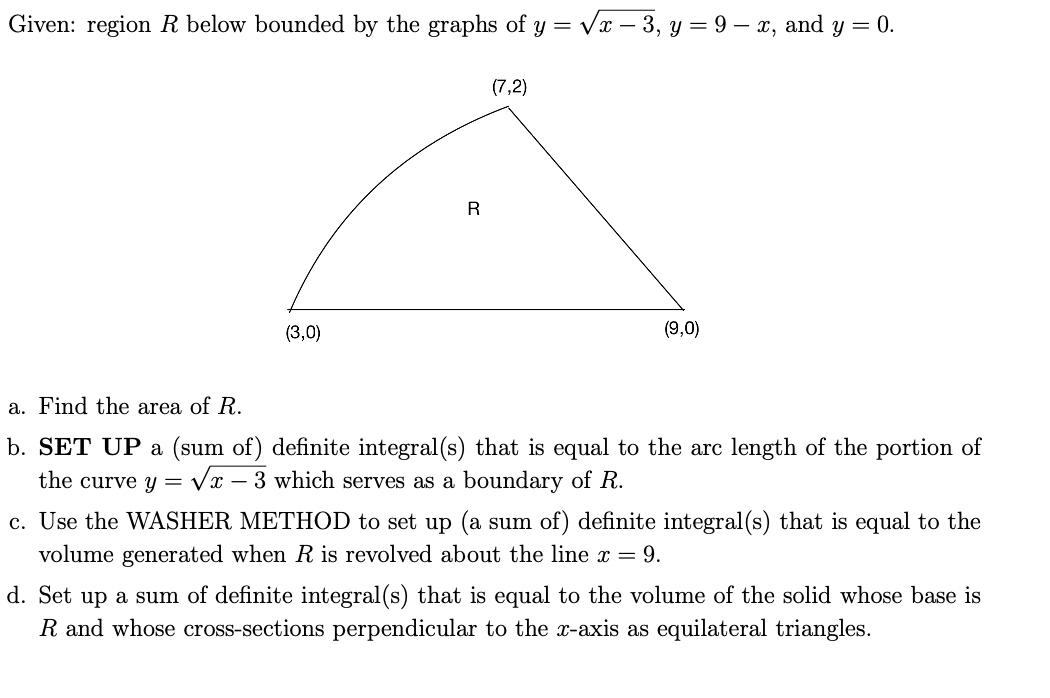Given: region R below bounded by the graphs of y = √x - 3, y = 9 - x, and y = 0. /x- (7,2) R (3,0) (9,0) a. Find the area of R. b. SET UP a (sum of) definite integral(s) that is equal to the arc length of the portion of √x-3 which serves as a boundary of R. the curve y - c. Use the WASHER METHOD to set up (a sum of) definite integral(s) that is equal to the volume generated when R is revolved about the line x = 9. d. Set up a sum of definite integral(s) that is equal to the volume of the solid whose base is R and whose cross-sections perpendicular to the x-axis as equilateral triangles.
Given: region R below bounded by the graphs of y = √x - 3, y = 9 - x, and y = 0. /x- (7,2) R (3,0) (9,0) a. Find the area of R. b. SET UP a (sum of) definite integral(s) that is equal to the arc length of the portion of √x-3 which serves as a boundary of R. the curve y - c. Use the WASHER METHOD to set up (a sum of) definite integral(s) that is equal to the volume generated when R is revolved about the line x = 9. d. Set up a sum of definite integral(s) that is equal to the volume of the solid whose base is R and whose cross-sections perpendicular to the x-axis as equilateral triangles.
Calculus: Early Transcendentals
8th Edition
ISBN:9781285741550
Author:James Stewart
Publisher:James Stewart
Chapter1: Functions And Models
Section: Chapter Questions
Problem 1RCC: (a) What is a function? What are its domain and range? (b) What is the graph of a function? (c) How...
Related questions
Question
Please answer d only

Transcribed Image Text:Given: region R below bounded by the graphs of y = √x - 3, y = 9 - x, and y = 0.
/x-
(7,2)
R
(3,0)
(9,0)
a. Find the area of R.
b. SET UP a (sum of) definite integral(s) that is equal to the arc length of the portion of
√x-3 which serves as a boundary of R.
the curve y
-
c. Use the WASHER METHOD to set up (a sum of) definite integral(s) that is equal to the
volume generated when R is revolved about the line x = 9.
d. Set up a sum of definite integral(s) that is equal to the volume of the solid whose base is
R and whose cross-sections perpendicular to the x-axis as equilateral triangles.
Expert Solution
This question has been solved!
Explore an expertly crafted, step-by-step solution for a thorough understanding of key concepts.
Step by step
Solved in 2 steps with 2 images

Recommended textbooks for you

Calculus: Early Transcendentals
Calculus
ISBN:
9781285741550
Author:
James Stewart
Publisher:
Cengage Learning

Thomas' Calculus (14th Edition)
Calculus
ISBN:
9780134438986
Author:
Joel R. Hass, Christopher E. Heil, Maurice D. Weir
Publisher:
PEARSON

Calculus: Early Transcendentals (3rd Edition)
Calculus
ISBN:
9780134763644
Author:
William L. Briggs, Lyle Cochran, Bernard Gillett, Eric Schulz
Publisher:
PEARSON

Calculus: Early Transcendentals
Calculus
ISBN:
9781285741550
Author:
James Stewart
Publisher:
Cengage Learning

Thomas' Calculus (14th Edition)
Calculus
ISBN:
9780134438986
Author:
Joel R. Hass, Christopher E. Heil, Maurice D. Weir
Publisher:
PEARSON

Calculus: Early Transcendentals (3rd Edition)
Calculus
ISBN:
9780134763644
Author:
William L. Briggs, Lyle Cochran, Bernard Gillett, Eric Schulz
Publisher:
PEARSON

Calculus: Early Transcendentals
Calculus
ISBN:
9781319050740
Author:
Jon Rogawski, Colin Adams, Robert Franzosa
Publisher:
W. H. Freeman


Calculus: Early Transcendental Functions
Calculus
ISBN:
9781337552516
Author:
Ron Larson, Bruce H. Edwards
Publisher:
Cengage Learning